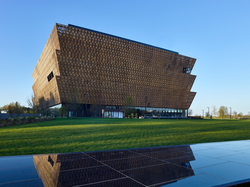After thirteen long years, the National Museum of African American History and Culture has opened9/30/2016
 Jessica Dorcelien Editor-in-Chief Back in 2003, then-current President George W. Bush signed a bill establishing the creation of the nineteenth, and final, museum of the Smithsonian Institution. Recently, on Sept. 24, 2016, the National Museum of African American History and Culture opened making it the “only [museum] in the United States exclusively focused on African American life, history, and culture.” The building, designed by David Adjaye and built on the last available land of the National Mall, is three-tiered and features a structure on top that is inspired by a traditional African headdress, or crown, that glows at night. The exterior of building is made of 3,600 bronze panels to express “faith, hope, and resiliency”. The opening dedication ceremony was hosted by President Barack Obama and was attended by a large number of public figures, including civil rights icon Representative John Lewis and former presidents George W. Bush and Bill Clinton. Performances that took place included ones by Stevie Wonder, Patti LaBelle, and Denyce Graves in addition to readings of black poets and historians by celebrities like Angela Basset. Obama spoke during the ceremony of how he hopes the museum will contribute to the everyday American lifestyle. He said, “[This] museum can provide context to the current national debate on the relationship between law enforcement and black communities. Perhaps it can help a white visitor understand the pain and anger of the demonstrators in places like Ferguson (Missouri) and Charlotte).”
The museum is charter by over 100,000 individuals and houses over 36,000 artifacts. Exhibits of the museum include topics of the Reconstruction, the Civil Rights Movement, the Black Power era of the 1960s and 1970s, and the legacy of President Obama’s election. Items include a slave cabin from South Carolina, a bill of sale for a sixteen year old girl for $600, a copy of the Emancipation Proclamation, Harriet Tubman’s hymn book, a dress Rosa Parks was in the process of making before her arrest, a Tuskegee airplane used to train African American pilots during World War II, a segregate Pullman train car, a stool from the Woolworth store with the Greensboro, North Carolina, sit-ins, and separate water fountains. There are so many artifacts to be viewed that the items are rotated in and out of exhibiting space. An additional section of the museum is dedicated to the celebration of achievements in sports, music, television, and film by members of the African American community. This section includes Michael Jackson’s fedora, Muhammad Ali’s headgear, Chuck Berry’s Cadillac, Jackie Robinson’s bat, and belongings of Gabby Douglas. The significance of the new Smithsonian is its ability to shed light on the interconnectedness of African American accomplishments and overcomings with the overall American history. The Smithsonian brings attention to Lyles Station, Indiana, the two hundred year old farming community that was settled by free African Americans before the Civil War. Lyles Station was a haven of free blacks who were able to buy and maintain their own land. “We weren’t wrote about or talked about, but we were involved in the process of building the country,” says Stanley Madison, a farmer and historian of Lyles Station. It will be as a result of National Museum of African American History and Culture that Lyles Station and others monumental stories like it will become better known. The NMAAHC is open to all visitors who are welcome to “participate, collaborate, and learn more about African American history and culture.” Comments are closed.
|
Archives
March 2017
Categories
All
|

